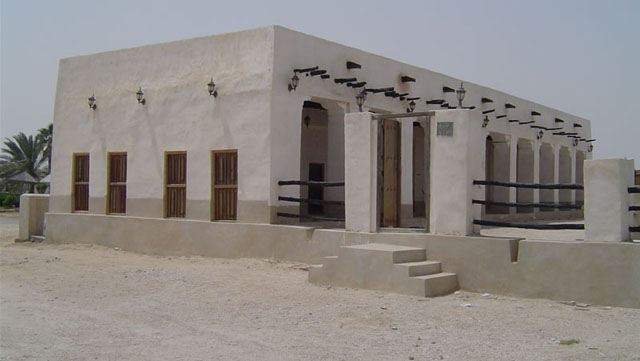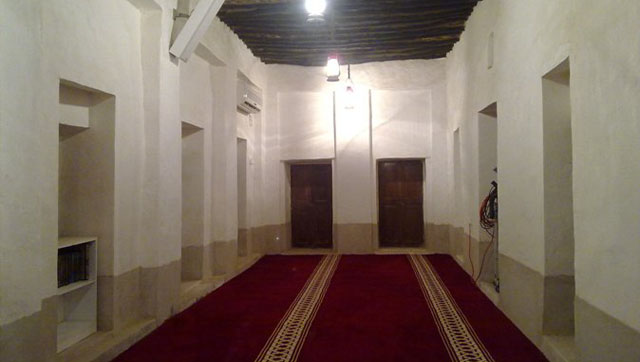Simaisma mosque
Mosques have always been the heart of villages in Qatar. The one in Simaisma, a town built in the 19th century by fishermen and pearl divers, dates back to 1938. It served as a place for prayer, but also a center for education. In front of the prayer room, a pavilion housed a madrassa: a school used to teach the Holy Quran to children.
The prayer room stands on the west side of the courtyard. Before entering it, Muslims must perform a long sequence of body cleaning actions called wudu, or ablutions.
Visitors of other religions are encouraged to do the same, as a form of intercultural respect and to learn one of the oldest Islamic traditions. Islamweb (link to the page where the movie is found) features a movie explaining this sequence of steps.
Normally the ablutions take place in the mothawaddah, which is a pool filled with water from a spring or a well.
At Simaisma mosque the mothawaddah is located at the southeast corner of the courtyard.
After the wudu, the ablutions, worshipers and visitors may enter the prayer room. In front of the prayer rooms entrance is an iwan, or portico, with nine squared arcades overlooking the courtyard.
The prayer room is a long, carpeted corridor discreetely lit by narrow windows. The mehrab, in front of the entrance, indicates the direction of the Kaaba, the Holy Stone at Mecca, Saudi Arabia. In this mosque, the mehrab consists of two arches, one of which houses a minbar, or podium.
Normally the imam, who is responsible for leading prayer, stands facing the congregation in front of the mehrab. On Fridays, he usually gives a religious speech from the podium.
In front of the prayer room, a pavilion houses a madrassa, which is a school used to teach the Holy Quran to children. The old Quranic school stands at the northeast corner of the sahn, or courtyard.
No longer functioning as a school, the structure has been used most recently as a residence for the muezzin, who is responsible for the call to prayer.
The pavilion consists of a small room cooled with badjeer, traditional Qatari air traps, instead of ordinary windows. This system features two parallel walls: one standing from the floor to halfway up and the second hanging halfway down from the ceiling.
The walls overlap by 10 cm, with breathing room left between. Although this method shelters the room from external view, it allows wind to enter without bringing in sediment. When necessary, the space between the two wall panels can be closed
with a wooden shutter.
Besides the Quranic school, a steep staircase climbs up to the minaret, which was built on top of the school. The top of the minaret is shaped as a khodha, a traditional
Arabian helmet. A few examples of this fascinating helmet can be found at the Sheikh Faisal bin Qassim Al-Thani Museum (object code: C002 and C02).
The thick walls of the mosque, which help keep the mosque cool, were built by overlapping raw pieces of coral rock and limestone. The roof was finished with a layer of compressed mud, which further protects the mosque from the sun during the hot seasons.
It is possible to see these building techniques in greater detail either through a visit to the fishermens villages in the northwest or by viewing the 3D model of the Qatari mosque.
Aware of the importance of this traditional building, Qatari authorities took steps to preserve it in 1985 and 2004.
Planning a visit
The mosque is usually open from sunrise to late afternoon. Visitors are advised not to enter the mosque or take pictures during prayer time. You can buy refreshments and snacks near the mosque. If you walk south, and the tide is low, you can see the hadra, which are traditional intertidal fishing traps. These square traps have stones on three sides with an open side toward the shore. As the tide rises fish swim inside, and as the tide goes back out they become trapped.
UTM coordinates N 25° 34' 28.78" E 51° 29' 16.08"
Address:
Simaisma is approximately 45 km north of Doha. Take the North Road or Lusail Street 30 km out of the city. Both roads have signs directing you to the town.












